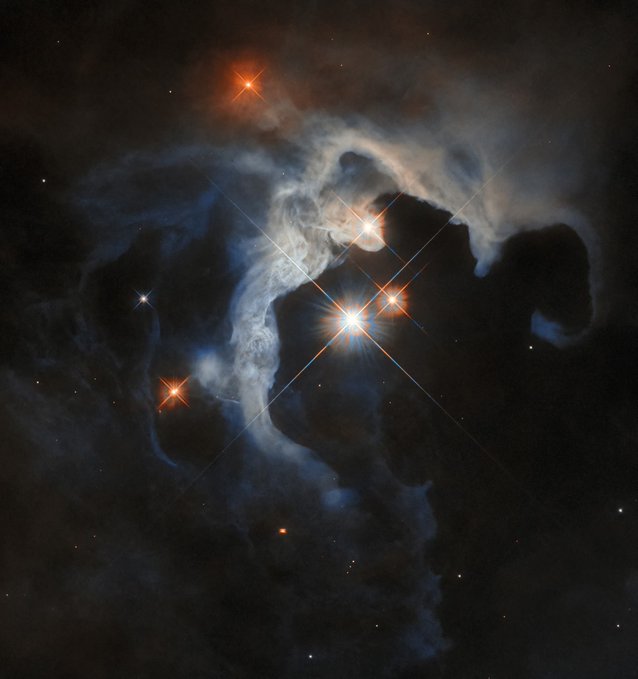[GUEST ACCESS MODE: Data is scrambled or limited to provide examples. Make requests using your API key to unlock full data. Check https://lunarcrush.ai/auth for authentication information.]  Black Hole [@konstructivizm](/creator/twitter/konstructivizm) on x 755.9K followers Created: 2025-07-20 06:38:00 UTC What you’re seeing here isn’t just a beautiful cloud in space — it’s a stellar nursery, where stars are being born. This delicate, smoky structure is GN 04.32.8, a reflection nebula glowing softly in shades of grey and blue. Unlike other nebulae that blaze with their own energy, reflection nebulae shine only when starlight scatters off their dust. That’s why many, like this one, take on a bluish hue — light, scattered like sunlight in Earth’s sky. GN 04.32.8 is just a fragment of the Taurus Molecular Cloud, one of the closest and richest star-forming regions to Earth, located about XXX light-years away in the constellation Taurus. At its center, a trio of bright young stars illuminates the dust — the most prominent being V1025 Tauri, a variable star that flickers as it evolves. Alongside it are HP Tau G2 and HP Tau G3. Together, they form a gravitationally bound triple system — a chaotic family of infant suns in a turbulent corner of the galaxy. But look closer. Just beneath the main cloud, left of center, there’s a small, amber-colored object crossed by a dark line. This is no ordinary star — it’s a protostar, still wrapped in the very disc of gas and dust that may one day give birth to planets. The dark line is the shadow of its protoplanetary disc, seen edge-on — a rare and valuable view for astronomers hoping to understand how solar systems like ours take shape. With Hubble’s sharp eyes fixed on it, we’re catching a glimpse of a future star system in its earliest days — a place where worlds may soon emerge. Credit: ESA/Hubble & NASA, G. Duchêne  XXXXX engagements  **Related Topics** [coins energy](/topic/coins-energy) [Post Link](https://x.com/konstructivizm/status/1946821877441139151)
[GUEST ACCESS MODE: Data is scrambled or limited to provide examples. Make requests using your API key to unlock full data. Check https://lunarcrush.ai/auth for authentication information.]
 Black Hole @konstructivizm on x 755.9K followers
Created: 2025-07-20 06:38:00 UTC
Black Hole @konstructivizm on x 755.9K followers
Created: 2025-07-20 06:38:00 UTC
What you’re seeing here isn’t just a beautiful cloud in space — it’s a stellar nursery, where stars are being born.
This delicate, smoky structure is GN 04.32.8, a reflection nebula glowing softly in shades of grey and blue. Unlike other nebulae that blaze with their own energy, reflection nebulae shine only when starlight scatters off their dust. That’s why many, like this one, take on a bluish hue — light, scattered like sunlight in Earth’s sky.
GN 04.32.8 is just a fragment of the Taurus Molecular Cloud, one of the closest and richest star-forming regions to Earth, located about XXX light-years away in the constellation Taurus. At its center, a trio of bright young stars illuminates the dust — the most prominent being V1025 Tauri, a variable star that flickers as it evolves. Alongside it are HP Tau G2 and HP Tau G3. Together, they form a gravitationally bound triple system — a chaotic family of infant suns in a turbulent corner of the galaxy.
But look closer. Just beneath the main cloud, left of center, there’s a small, amber-colored object crossed by a dark line. This is no ordinary star — it’s a protostar, still wrapped in the very disc of gas and dust that may one day give birth to planets. The dark line is the shadow of its protoplanetary disc, seen edge-on — a rare and valuable view for astronomers hoping to understand how solar systems like ours take shape.
With Hubble’s sharp eyes fixed on it, we’re catching a glimpse of a future star system in its earliest days — a place where worlds may soon emerge.
Credit: ESA/Hubble & NASA, G. Duchêne

XXXXX engagements
Related Topics coins energy